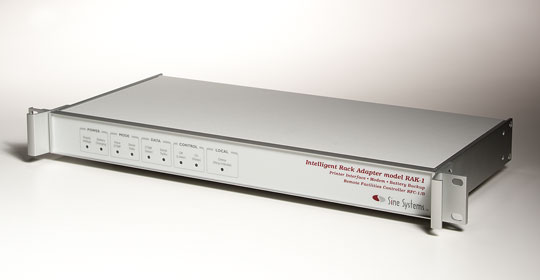Model RAK-1

RAK-1 Intelligent Rack Adapter
Click image for more views
Features
Intelligent Rack Adapter
The Intelligent Rack Adapter is the ultimate upgrade for the Remote Facilities Controller model RFC-/B. This accessory package provides data communications and printing capabilities, a battery backed power supply, telephone line surge suppression and front panel status indicators in a sleek, rack-mountable aluminum chassis.
Better still, the RAK-1 is available as an upgrade for existing RFC-1/B installations. This protects your investment in the RFC-1/B Remote Facilities Controller that you already own. Of course, if you do not already own an RFC-1/B, the RAK-1 is offered on new systems, too. When ordered as the RFC-1/RAK, we will assemble and test the system at the factory.
Data Communications
The RAK-1 contains a 2400 baud AT
command set modem. The modem allows the RFC-1/B to be polled for telemetry data and controlled by an external computer at a remote site. The RFC-1/B can also log telemetry data and place alarm calls through the modem.
The modem uses the same telephone line that is used for voice/DTMF operation so new lines are not necessary. The RFC-1/B firmware has the necessary intelligence to place outgoing data calls to log data without assistance from an external computer.
Parallel Printer Port
The parallel printer port allows an inexpensive parallel printer to be attached to the RAK/RFC system so that telemetry readings and/or system alarms can be logged to a local printer. Flexible programming in the RFC-1/B allows you to program how often readings will print.
The printer must be a true parallel printer and not a Windows printer
that uses a parallel interface. Windows printers lack some of the necessary intelligence to handle simple printing tasks.
Battery Backup
A set of batteries inside the RAK-1 allows the system to operate even when AC power is lost. Operating from the batteries, the RFC/RAK system can alert station personnel of the improper condition. When AC power returns, the batteries will recharge.
The time that the system will operate from the batteries varies according to the age and condition of the batteries and system programming. New batteries power the system for approximately six hours with factory settings.
Surge Suppression
Surprisingly, the vast majority of damage from lighting on remote control systems comes, not through telemetry sources or power supply, but from the telephone network. The RAK-1 uses a system of heavy duty gas surge arrestors, metal oxide varistors and polyswitch type fuses to suppress damaging electrical spikes before they can harm the system.
The system should still be protected from spikes that may pass through telemetry sources. For that we recommend the SP-8/TO Heavy Duty Surge Protector–an inexpensive device that attaches to the relay panel and protects the eight telemetry inputs from damaging spikes.
System Requirements
The RAK-1 can be purchased with the RFC-1/B main board already installed or as an upgrade for an existing RFC-1/B installation. The existing installation must have firmware version 4.00 or later–this is also referred to as software
in RFC-1/B documentation. Most RFC-1 systems are running version 5.x so this is typically not an issue.
Use the command "78" while online with the RFC-1 to read the software version.
At least one RP-8 Relay Panel is required for any RFC-1 installation. The RP-8 supplies eight channels of telemetry and control I/O to the system. If the RAK-1 is installed as an upgrade to a previously functioning RFC-1/B system, an RP-8 is already in service. Otherwise, RP-8s are ordered separately.
A single telephone line terminated in a standard modular (RJ11C) type connector is necessary for communications. This line will be used for both voice and data communications. A single line telephone is required for programming and local control of the RFC-1/B. Speaker phones are not recommended unless they are self-powered.
The RAK-1 requires a single grounded power supply outlet. The internal, battery backed supply replaces the 12 volt AC transformer that the RFC-1/B uses in a stand-alone
installation.
